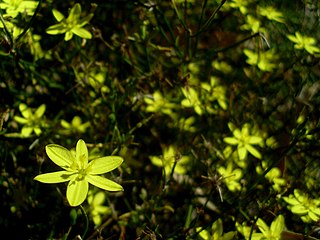
Soursop is the fruit of Annona muricata, a broadleaf, flowering, evergreen tree. The exact origin is unknown; it is native to the tropical regions of the Americas and the Caribbean and is widely propagated. It is in the same genus, Annona, as cherimoya and is in the Annonaceae family.

The bishop pine, Pinus muricata, is a pine with a very restricted range: mostly in California, including several offshore Channel Islands, and a few locations in Baja California, Mexico. It is always on or near the coast.

Stackhousia is a genus of annual and perennial plants in the family Celastraceae that are native to Australia, New Zealand, Malesia and Micronesia. The genus was first described by James Edward Smith in Transactions of the Linnean Society of London in 1798.

Tricoryne is a genus of perennial herbs in the family Asphodelaceae, subfamily Hemerocallidoideae. All species are native to Australia with two species extending to New Guinea; within Australia they occur in all 6 states and the Northern Territory.
- Tricoryne ancepsR.Br. - New Guinea, Queensland
- Tricoryne corynothecoidesKeighery - Western Australia
- Tricoryne elatiorR.Br. - Yellow Rush-lily - all 6 states plus Northern Territory
- Tricoryne humilisEndl. - Western Australia
- Tricoryne muricataBaker - Queensland
- Tricoryne platypteraRchb.f - New Guinea, Queensland
- Tricoryne simplexR.Br. - New South Wales
- Tricoryne tenellaR.Br. - Mallee Rush-lily - Western Australia, South Australia
Stackhousia subterranea is a perennial herb species in the family Celastraceae. The species occurs in South Australia and Victoria and Tasmania

Stackhousia viminea the Slender Stackhousia is a common small Australian plant. It grows to 70 cm tall. The habitat is heathland, pastures, eucalyptus woodland and forest, usually in moist areas. It features attractive yellowish/red flowers. The specific epithet viminea refers to the slender stems. The genus is named after the botanist and artist, John Stackhouse

Stackhousia monogyna, commonly known as creamy stackhousia or creamy candles, is a perennial herb species in the family Celastraceae. It is native to Australia. Plants grow to 70 cm (28 in) high and produce a terminal spike of white, cream or yellow flowers between August and January in the species native range.

Beyeria Conservation Park is a protected area in the Australian state of South Australia located on Kangaroo Island in the gazetted locality of Haines about 16 kilometres south of Kingscote on the northern edge of the MacGillivray Plain. It was proclaimed on 14 May 1987 following requests to the state government by conservation groups and botanists to prevent further land clearing for agriculture in the vicinity, as well as to protect populations of rare plant species. The name of the conservation park is taken from the generic name of one of the plants so protected – the Kangaroo Island Turpentine Bush.

Acropora muricata, commonly called staghorn coral, is a species of acroporid coral found in the Gulf of Aden, the Red Sea, Indian Ocean, Persian Gulf, Australia, central Indo-Pacific, Japan, Southeast Asia, the East China Sea and the oceanic central and western Pacific Ocean. It is found in tropical shallow reefs, slopes of reefs, and in lagoons, from depths of 5 to 30 m. It was described by Dana in 1846.
Acacia aemula is a shrub belonging to the genus Acacia and subgenus Alatae. It is native to an area along the south coast of Western Australia.
Acacia ataxiphylla, commonly known as the Large-fruited Tammin wattle, is a shrub belonging to the genus Acacia. It is native to Western Australia.
Baeckea muricata is a shrub endemic to Western Australia.

Stackhousia clementii is a species of plant in the Celastraceae family.
Stackhousia dielsii, commonly known as yellow stackhousia, is a species of plant in the Celastraceae family.
Stackhousia huegelii is a species of plant in the Celastraceae family.
Stackhousia pubescens, commonly known as downy stackhousia, is a species of plant in the Celastraceae family.
Stackhousia scoparia is a species of plant in the Celastraceae family.
Stackhousia stratfordiae is a species of plant in the Celastraceae family.
Stackhousia umbellata is a species of plant in the Celastraceae family.

Coscinasterias muricata is a species of starfish in the family Asteriidae. It is a large 11-armed starfish and occurs in shallow waters in the temperate western Indo-Pacific region.













